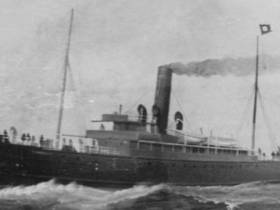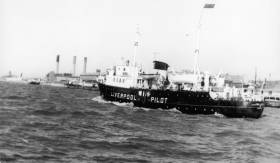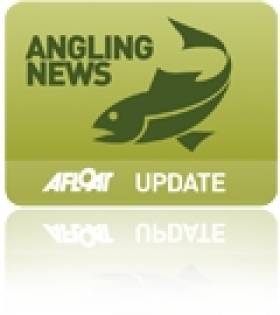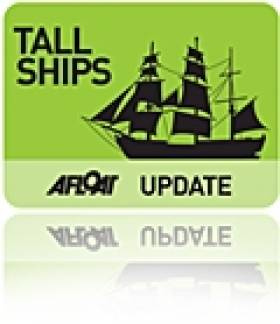Displaying items by tag: exhibition
Exhibition in Isle of Man to Commemorate Loss of Mona's Queen During Dunkirk's Operation Dynamo
An exhibition about the Isle of Man Steam Packet's passenger steamer Mona's Queen which was lost at Dunkirk in northern France during WW 2 is to take place on 22nd May.
The exhibition writes EnergyFM, is to commemorate the Mona's Queen which on May 29th 1940, was struck by a German mine on the way into Dunkirk to help with Operation Dynamo.
Of the vessel's 24 crew who died, seventeen were from the Isle of Man.
For two weeks the exhibition display will take place in the south-west of the island at Port St Mary's (Town Hall) where as Afloat reported, two cruise ships are to call offshore this season as part of a record year.
The story of the Mona's Queen (III) which was built by Cammell Laird, Birkenhead in 1934 will be told through exhibits of launch photos from the Merseyside shipyard, original plans for the ship, apprentices model, original tableware and the ship's pennants.
There will also be a video of the wreck today. Next month, a dive team from the Isle of Man will be travelling to Dunkirk to photograph and video the Mona’s Queen wreck.
Also to be on display at Port St. Mary will be the stories of other Steam Packet ships and their crews.
#CoastalNotes - The economic, emotional and communal effects is encompassed in an exhibiton about the sinking of the SS Dundalk 100 years ago which was officially launched recently at the County Museum, Dundalk, by UK Defence Attaché, Colonel Darren Doherty.
The SS Dundalk, a 235-foot-long merchant ship, writes the Dundalk Democrat was on her return trip from Liverpool’s Collinwood Dock to Dundalk Harbour on 14th October 1918 when she was torpedoed by a German submarine. The attack and subsequent sinking of the ship claimed 20 lives - 19 crew and one passenger, most of whom were local to Dundalk and surrounding areas.
The ‘SS Dundalk’ exhibition explores topics such as Louth’s booming port trade in the early 1900s, German WWI strategies, life in Dundalk during the war, and the effect of the loss of life on the victims’ families and friends.
To read more click the newspaper link here
In Safe Hands: The Story of the Liverpool Pilots
#Exhibition - Dublin Port has strong historical trading links across the Irish Sea with the Port of Liverpool. The English north-west port is where an exhibiiton: In Safe Hands-The Story of the Liverpool Pilots is on display at the Merseyside Maritime Museum.
So set sail with the Liverpool Pilots on a journey from 1766, through the world wars and onto the thriving modern port of Liverpool. The exhibition (ending 4 June) tells the story of the heroic Liverpool Pilots and explores their vital role in navigating ships in and out of the Port of Liverpool.
Marking the 250th anniversary of the Liverpool Pilotage Service in 2016, In safe hands highlights dramatic examples where the Pilots’ judgement and bravery have saved lives and cargo from disaster. Liverpool waters are some of the toughest in the world to navigate. Ships entering Liverpool Bay and the River Mersey face serious hazards and rely on the skills and knowledge of pilots to ensure their safe passage.
The exhibition explores the development of the Pilotage service within the wider history of the Port of Liverpool, from the explosion of growth in the 18th and 19th centuries, decline in the mid to late 20th century, through to the thriving port of the 21st century.
Meet the Liverpool Pilots
Watch videos about:
The Three Cunard Queens' visit to Liverpool.
What makes a good pilot?
Life at sea on a pilot ship
Free events
The exhibition is accompanied by talks by award-winning guides on board former pilot station ship, Edmund Gardner. For more information click: In Safe Hands events.
Skibbereen Caught By a Lens
#Rowing: The West Cork arts centre, Uillinn, is hosting an exhibition of images of Skibbereen Rowing Club. Photographer Debbie Heaphy recorded the action at the club for four years, often accompanying coach Dominic Casey in his launch on early morning training sessions. “Having spent the last four years with these athletes, I am totally in awe of the resilience, focus and commitment of these young people. I have watched them strive to achieve what, at times, would seem to be unreachable goals,” Heaphy said.
The year 2015 was a very successful one for the club, with 17 Skibbereen athletes rowing for the Irish national squad, and two rowers, brothers Gary and Paul O’Donovan, qualified for the 2016 Olympic Games in Rio de Janeiro.
This exhibition is a compilation of what Heaphy regards as her best photographs from her time at the club. “I hope to portray the intensity of training and the essence and sense of place of the Ilen River, and also a snap shot of the unique and extraordinary journey of the boys and girls from Skibbereen who are determined to take on the world.”
There is a limited-edition book of photographs and essays on sale. Sales of this publication and the photographs on exhibition will go towards raising funds for the club.
The book also be purchased directly from www.skibbereenrowingclub.com or www.debbieheaphyenvironment.com
Second Irish Fly Fair Set To Be Bigger and Better
#ANGLING - The Irish Fly Fair and Angling Show at the Galway Bay Hotel next weekend be "the biggest of its kind in Ireland", hosting the largest number of fly tyers and trade stands from over 15 countries, according to organisers.
The two-day exhibition, now in its second year, will welcome some of the world's top fly tyers and angling celebrities to Salthill.
As with the first event last November, visitors will have the opportunity to learn from the world's best fly dressers and casters, with tuition provided by APGAI Ireland.
Returning angling celebs Hywel Morgan, Glenda Powell, Stevie Munn, Paddy McDonnell, Peter O’Reilly will be joined by newcomer Scott MacKenzie to advise on all aspects of fly fishing.
Among the new events this year is the youth fly tying competition, giving younger anglers a chance to show the pros what they can do.
Experts from Inland Fisheries Ireland, the Wild Trout Trust and many more will also be hosting talks and seminar on various angling-related topics.
And all that is aside from the huge trade aspect of the weekend.
"Building on the success of last year’s show, where business was brisk, the 2011 show has attracted trade from all over Europe who are keen to come to Galway and exhibit to the Irish market," said organiser Grace McDermott.
For more details on the second annual Irish Fly Fair and Angling Show visit www.irishflyfair.com.
New Centre at Dunbrody Tells the Irish-American Story
Tomorrow sees the official opening ceremony of Ireland's first visitor centre dedicated to the history of emigration.
The National Centre for Emigration History in New Ross, Co Wexford, which incorporates the Irish America Hall of Fame, will be opened by Minister for Transport, Tourism and Sport Leo Varadar, joined by famous Irish-American Michael Flatley.
Located on the quay side of the River Barrow next to the popular tall ship Dunbrody, which commemorates the Great Famine, the €2.6 million interative centre features a state-of-the-art exhibition on the story of Irish emigration, plus a genealogical resource for visitors hoping to trace their Irish heritage.
Titanic Artifacts Surface at New Exhibition
Relics from the Titanic will get their first public airing at an exhibition in Co Down this month.
The Newsletter reports that the new display at Cultra's Folk and Transport Museum - which will be opened on 31 May - comprises 35 items from the doomed ship, including part of the hull, silver and glassware and a number of personal items.
"Nothing tells the story of Titanic more poignantly and dramatically than these artifacts," said Alexandra Klingelhofer of RMS Titanic Ltd, which has loaned the items to the museum.
The new exhibition marks 100 years since the launch of the Titanic from the Harland and Wolff shipyards in Belfast.
Dublin Bay it set to burst alive with 'joie de vivre' during the only foreign stopover in the world-famous Solitaire du Figaro yacht race.
Dun Laoghaire will be the only international stop in the race, considered the unofficial world offshore solo championship, between 11 and 14 August.
To celebrate the visit of the iconic 3,390km race, Dun Laoghaire Rathdown County Council (dlrcoco), the Dun Laoghaire Harbour Company and the National Yacht Club have joined forces to create the Festival des Bateaux.
The harbour will be a magnificent tapestry of colour as the boats arrive for this international event. Dun Laoghaire will be resplendent with fireworks, music and the sights, sounds, foods and ‘joie de vivre’ of France.
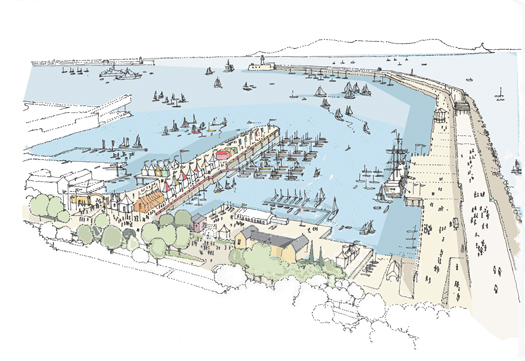
How Dun Laoghaire will look in August
Fireworks will light up the sky at 10pm on Friday 12 August. There will also be a festival village with public access to visiting boats, a colourful and authentic French market and exhibition, a festival stage at Harbour Plaza and activities throughout Dun Laoghaire, not to mention a spectacular farewell as the boats depart early on Sunday 14 August.
Meanwhile, plans to berth the 45 or so competitors expected are well underway, according to the National Yacht Club.
Funding was secured between dlrcoco and Fáilte Ireland, and the tender for the supply and delivery of 18x11.5m pontoons and associated service bollards was won by McNiven Marine, Irish agents for Ronautica Marine.
The gangway contract was secured by Tynes Gangway, and the last contract for the installation and de-commissioning of the infrastructure is currently underway.


























